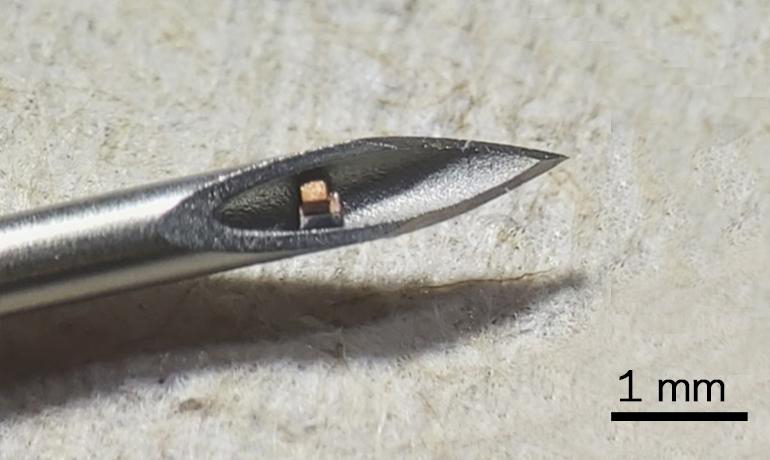


Researchers at Columbia University have developed a microscopic implantable chip for physiological monitoring. It has a total volume of less than 0.1 mm3; the chip is as small as a dust mite and can only be viewed using a microscope. This research aimed to create devices that can be injected using a standard hypodermic needle, and which then beam their readings wirelessly to external displays such as patient monitors and smartphones. The Columbia team used externally applied ultrasound through a conventional ultrasound imager to power and communicate with their implant.
Medical implants offer huge benefits in terms of patient monitoring. Researchers are developing a host of such devices to monitor various biological parameters, from vital signs to glucose levels. However, as with other electronics, technological progress is typically coupled with miniaturization. In the field of medical implants, smaller isn’t just sleeker but also helps with ease of implantation and minimizing side effects.
“We wanted to see how far we could push the limits on how small a functioning chip we could make,” said Ken Shepard, a researcher involved in the study, via a press release. “This is a new idea of ‘chip as system’–this is a chip that alone, with nothing else, is a complete functioning electronic system. This should be revolutionary for developing wireless, miniaturized implantable medical devices that can sense different things, be used in clinical applications, and eventually approved for human use.”

The researchers report that they have created the world’s smallest single-chip system. The device uses ultrasound as a power source and to communicate with an external device. The team chose this modality as the wavelength of electromagnetic waves is too large to function with such a tiny device. In contrast, the wavelength for ultrasound is much smaller at a given frequency.
“This is a nice example of ‘more than Moore’ technology–we introduced new materials onto standard complementary metal-oxide-semiconductor to provide new function,” said Shepard. “In this case, we added piezoelectric materials directly onto the integrated circuit to transducer acoustic energy to electrical energy.”
The current iteration of the device measures body temperature, but the technology can monitor a variety of biological parameters. So far, the researchers have demonstrated that the implants can monitor body temperature in mice and hope to develop the technology to the point where it could be used in human patients.
Study in Science Advances: Application of a sub–0.1-mm3 implantable mote for in vivo real-time wireless temperature sensing
Via: Columbia University
more recommended stories
 Safer Allogeneic Stem Cell Transplants with Treg Therapy
Safer Allogeneic Stem Cell Transplants with Treg TherapyA new preclinical study from the.
 Autoimmune Disorders: ADA2 as a Therapeutic Target
Autoimmune Disorders: ADA2 as a Therapeutic TargetAdenosine deaminase 2 (ADA2) has emerged.
 Kaempferol: A Breakthrough in Allergy Management
Kaempferol: A Breakthrough in Allergy ManagementKaempferol, a dietary flavonoid found in.
 Early Milk Cereal Drinks May Spur Infant Weight Gain
Early Milk Cereal Drinks May Spur Infant Weight GainNew research published in Acta Paediatrica.
 TaVNS: A Breakthrough for Chronic Insomnia Treatment
TaVNS: A Breakthrough for Chronic Insomnia TreatmentA recent study conducted by the.
 First-of-Its-Kind Gene-Edited Pig Kidney: Towana’s New Life
First-of-Its-Kind Gene-Edited Pig Kidney: Towana’s New LifeSurgeons at NYU Langone Health have.
 Just-in-Time Training Improves Success & Patient Safety
Just-in-Time Training Improves Success & Patient SafetyA study published in The BMJ.
 ChatGPT Excels in Medical Summaries, Lacks Field-Specific Relevance
ChatGPT Excels in Medical Summaries, Lacks Field-Specific RelevanceIn a recent study published in.
 Study finds automated decision minimizes high-risk medicine combinations in ICU patients
Study finds automated decision minimizes high-risk medicine combinations in ICU patientsA multicenter study coordinated by Amsterdam.
 Study Discovers Connection Between Omicron Infection and Brain Structure Changes in Men
Study Discovers Connection Between Omicron Infection and Brain Structure Changes in MenA recent study in the JAMA.

Leave a Comment